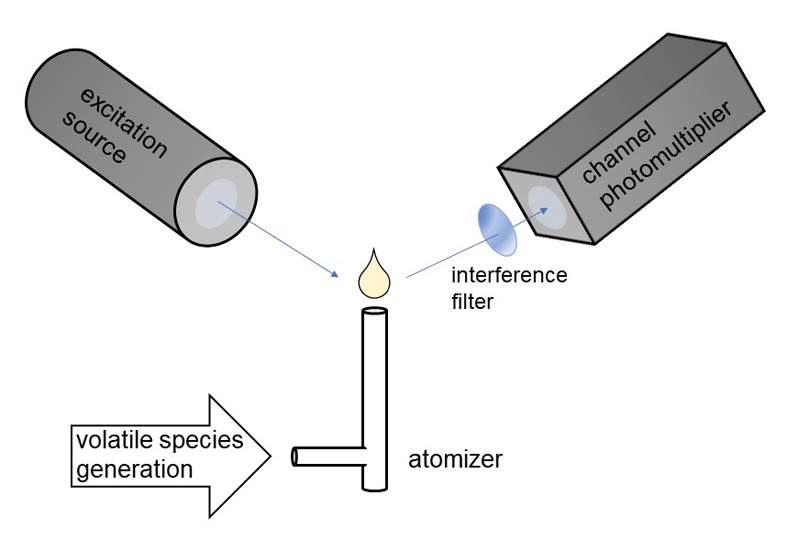Research
DEVELOPMENT OF FLEXIBLE AFS INSTRUMENT
The first analytical use of atomic fluorescence spectrometry (AFS) was demonstrated by Winefordner et al. in 1964. At that time, the limits of detection (LOD) were usually comparable with atomic absorption spectrometry (AAS) due to high background noise caused by scattered radiation on water droplets. Therefore, coupling AFS with generation of volatile species (VSG) improved LODs significantly. Nowadays, AFS offers much lower LOD compared to most commonly employed AAS. However, the application of commercial AFS instruments is limited only to few elements – the hydride forming elements - As, Bi, Se, Sb, Ge, Te - and Hg.
Our research activities in this field
A laboratory-made non-dispersive AFS instrument (simplified scheme in Fig. 1) was developed at our department, where an interference filter is used to isolate the fluorescence radiation from the atomizer and a solar blind channel photomultiplier is employed as the detector. The miniature diffusion flame (MDF) and flame-in-gas-shield (FIGS) atomizers are the two atomizers usually employed [1] (see paragraph Common atomizers). The first advantage of this spectrometer lies in the possibility of employing two types of radiation sources - either high intensity hollow cathode lamps (superlamps, usually employed in commercial instruments) or electrodeless discharge lamps (EDL), which results in reaching much lower LODs at ng L–1 level. The other advantage is that the applicability of this spectrometer is extended to a broader range of elements as not solely the hydride generator can be coupled with it.

Our spectrometer was first applied to the speciation analysis of As in real samples by means of cryogenic separation (CT) or by HPLC (see also paragraph Speciation Analysis). In both cases, much better LODs were achieved for As species, i.e. iAsIII, iAsV, MAsV, DMAsV, TMAsVO, compared with other published papers dealing with AFS: 0.15–0.74 ng L–1 for HG–CT–AFS with FIGS atomizer [2], 40–97 ng L–1 for HPLC–HG–AFS with MDF atomizer [3] and 10–40 ng L–1 for HPLC–HG–AFS with FIGS atomizer [4]. In addition, AFS instrumentation was utilized within other studies focused on mechanism and artefacts during VSG of As [5;6] or atomization of As in the DBD [7].
An applicability of this AFS instrument has been expanded to other elements recently when a methodology for Bi determination by HG-AFS was developed achieving extremely low LOD (0.9 ng L –1) [8], which is comparable even to ICP-MS, but obtained at a much lower investment and running cost. Recently, a photochemical vapor generator (see paragraph Photochemical generation of volatile species – exploring alternative routes to generation of volatile species) was successfully coupled to the spectrometer with Bi used as the analyte [9]. Coupling of other VSG techniques with AFS, as well as the possibility of using both superlamps and EDLs, offers new opportunities in determination of other than hydride forming elements such as transition metals, which is one of the research topics on which our attention is currently focused.
References
- 1. MARSCHNER K., MUSIL S., DĚDINA J.: Flame-in-gas-shield and miniature diffusion flame hydride atomizers for atomic fluorescence spectrometry: optimization and comparison. Spectrochimica Acta Part B: Atomic Spectroscopy, 109 (2015), 16–23.
- 2. MUSIL S., MATOUŠEK T., CURRIER J. M., STÝBLO M., DĚDINA J.: Speciation Analysis of Arsenic by Selective Hydride Generation-Cryotrapping-Atomic Fluorescence Spectrometry with Flame-in-Gas-Shield Atomizer: Achieving Extremely Low Detection Limits with Inexpensive Instrumentation. Analytical Chemistry, 86 (2014), 10422–10428.
- 3. MARSCHNER K., MUSIL S., DĚDINA J.: Achieving 100% Efficient Postcolumn Hydride Generation for As Speciation Analysis by Atomic Fluorescence Spectrometry. Analytical Chemistry, 88 (2016), 4041–4047.
- 4. MARSCHNER K., PÉTURSDÓTTIR Á. H., BÜCKER P., RAAB A., FELDMANN J., MESTER Z., MATOUŠEK T., MUSIL S.: Validation and inter-laboratory study of selective hydride generation for fast screening of inorganic arsenic in seafood. Analytica Chimica Acta, 1049 (2019), 20–28.
- 5. MARSCHNER K., MUSIL S., DĚDINA J.: Demethylation of Methylated Arsenic Species during Generation of Arsanes with Tetrahydridoborate(1–) in Acidic Media. Analytical Chemistry, 88 (2016), 6366–6373.
- 6. MARSCHNER K., MUSIL S., MIKŠÍK I., DĚDINA J.: Investigation of hydride generation from arsenosugars - Is it feasible for speciation analysis? Analytica Chimica Acta, 1008 (2018), 8–17.
- 7. STRAKA M., BURHENN S., MARSCHNER, K., BRANDT S., MARGGRAF U., DĚDINA J., FRANZKE J., KRATZER J.: Novel designs of dielectric barrier discharge.


